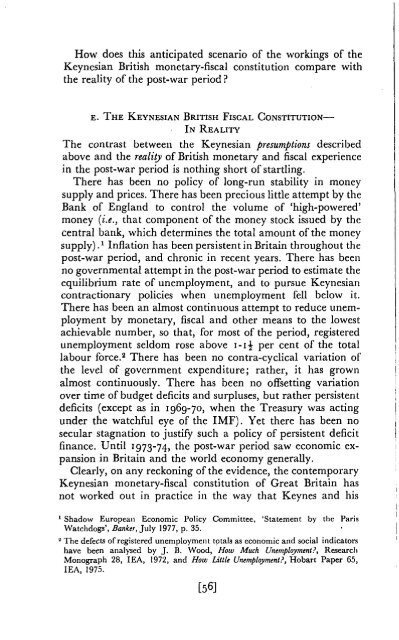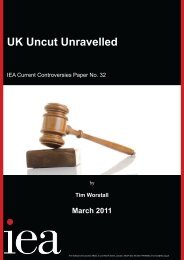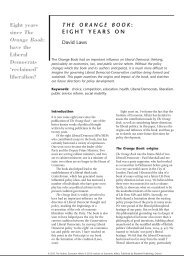THE CONSEQUENCES OF MR KEYNES.pdf - Institute of Economic ...
THE CONSEQUENCES OF MR KEYNES.pdf - Institute of Economic ...
THE CONSEQUENCES OF MR KEYNES.pdf - Institute of Economic ...
You also want an ePaper? Increase the reach of your titles
YUMPU automatically turns print PDFs into web optimized ePapers that Google loves.
How does this anticipated scenario <strong>of</strong> the workings <strong>of</strong> the<br />
Keynesian British monetary-fiscal constitution compare with<br />
the reality <strong>of</strong> the post-war period ?<br />
E. <strong>THE</strong> <strong>KEYNES</strong>IAN BRITISH FISCAL CONSTITUTION—<br />
IN REALITY<br />
The contrast between the Keynesian presumptions described<br />
above and the reality <strong>of</strong> British monetary and fiscal experience<br />
in the post-war period is nothing short <strong>of</strong> startling.<br />
There has been no policy <strong>of</strong> long-run stability in money<br />
supply and prices. There has been precious little attempt by the<br />
Bank <strong>of</strong> England to control the volume <strong>of</strong> 'high-powered'<br />
money (i.e., that component <strong>of</strong> the money stock issued by the<br />
central bank, which determines the total amount <strong>of</strong>the money<br />
supply). 1 Inflation has been persistent in Britain throughout the<br />
post-war period, and chronic in recent years. There has been<br />
no governmental attempt in the post-war period to estimate the<br />
equilibrium rate <strong>of</strong> unemployment, and to pursue Keynesian<br />
contractionary pohcies when unemployment fell below it.<br />
There has been an almost continuous attempt to reduce unemployment<br />
by monetary, fiscal and other means to the lowest<br />
achievable number, so that, for most <strong>of</strong> the period, registered<br />
unemployment seldom rose above I-I-_- per cent <strong>of</strong> the total<br />
labour force. 2 There has been no contra-cyclical variation <strong>of</strong><br />
the level <strong>of</strong> government expenditure; rather, it has grown<br />
almost continuously. There has been no <strong>of</strong>fsetting variation<br />
over time <strong>of</strong> budget deficits and surpluses, but rather persistent<br />
deficits (except as in 1969-70, when the Treasury was acting<br />
under the watchful eye <strong>of</strong> the IMF). Yet there has been no<br />
secular stagnation to justify such a policy <strong>of</strong> persistent deficit<br />
finance. Until 1973-74, the post-war period saw economic expansion<br />
in Britain and the world economy generally.<br />
Clearly, on any reckoning <strong>of</strong>the evidence, the contemporary<br />
Keynesian monetary-fiscal constitution <strong>of</strong> Great Britain has<br />
not worked out in practice in the way that Keynes and his<br />
1 Shadow European <strong>Economic</strong> Policy Committee, 'Statement by the Paris<br />
Watchdogs', Banker, July 1977, p. 35.<br />
2 The defects <strong>of</strong> registered unemployment totals as economic and social indicators<br />
have been analysed by J. B. Wood, How Much Unemployment?, Research<br />
Monograph 28, IEA, 1972, and How Little Unemployment?, Hobart Paper 65,<br />
IEA, 1975.<br />
[56]












